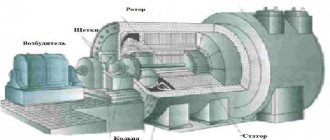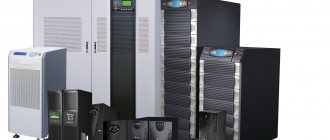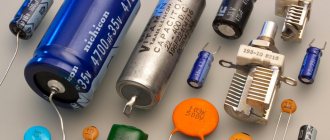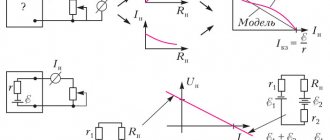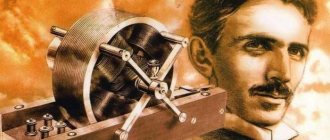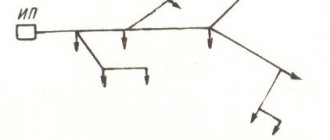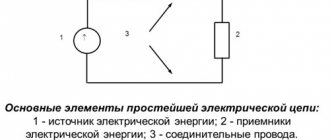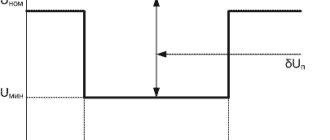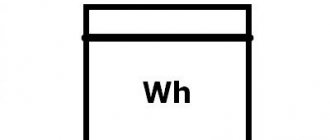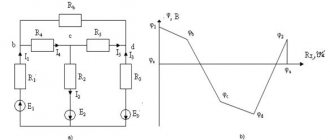What is the capacitance of a capacitor measured in?
One of the most important characteristics of a capacitor is its capacity. This parameter is determined by the amount of electricity accumulated by this device. The accumulation occurs in the form of electrons. The number of them placed in the capacitor determines the capacitance value of a particular device.
The unit used to measure capacitance is the farad. A capacitor's capacity of 1 farad corresponds to an electric charge of 1 coulomb, and the potential difference across the plates is 1 volt. This classical formulation is not suitable for practical calculations, since the capacitor collects not charges, but electrons. The capacity of any capacitor is directly dependent on the volume of electrons that can accumulate during normal operating conditions.
The farad is still used to denote capacitance, and the quantitative parameters are determined by the formula: C = Q / U, where C means capacitance, Q is charge in coulombs, and U is voltage. Thus, the mutual relationship between charge and voltage is visible, influencing the capacitor’s ability to accumulate and retain a certain amount of electricity.
To calculate the capacitance of a parallel-plate capacitor, the formula is used: in which ε = 8.854187817 x 10-12 f/m is a constant value. Other quantities: ε is the dielectric constant of the dielectric located between the plates, S is the area of the plate, and d is the gap between the plates.
Using capacitors
The ability of capacitors to smoothly collect electrical charge and release it quickly enough is used in various fields of technology.
Connection with inductors allows you to create oscillatory circuits, current filters, and feedback circuits.
Photoflashes and stun guns, in which an almost instantaneous discharge occurs, use the ability of a capacitor to create a powerful current pulse. The capacitor is charged from a direct current source. The capacitor itself acts as an element that breaks the circuit. The discharge in the reverse direction occurs through a low ohmic resistance lamp almost instantly. In a stun gun, this element is the human body.
Capacitor Energy Formula
Closely related to capacitance is another quantity known as the energy of a charged capacitor. After charging any capacitor, a certain amount of energy is formed in it, which is subsequently released during the discharge process. The capacitor plates interact with this potential energy. They form opposite charges that attract each other.
Capacitor field energy
All the energy of a charged capacitor is concentrated in the electric field between its plates. The energy stored in a capacitor can be determined as follows. Let's imagine that we do not charge the capacitor immediately, but gradually, transferring electrical charges from one plate to another.
When transferring the first charge, the work done by us will be small. We will spend more energy on transferring the second charge, since as a result of transferring the first charge between the plates of the capacitor there will already be a potential difference that we will have to overcome, the third, fourth and in general each subsequent charge will be more and more difficult to transfer, i.e. moving them will require more and more energy. Let us transfer in this way a certain amount of electricity, which we will denote by the letter Q.
All the energy we expended when charging the capacitor will be concentrated in the electric field between its plates. We denote the voltage between the plates of the capacitor at the end of the charge with the letter U.
As we have already noticed, the potential difference during the charging process does not remain constant, but gradually increases from zero - at the beginning of the charge - to its final value U.
To simplify energy calculations, let’s assume that we transferred the entire electric charge Q from one capacitor plate to another, not in small portions, but all at once. But at the same time, we must assume that the voltage between the plates of the capacitor was not zero, as at the beginning of the charge, and not U, as at the end of the charge, but was equal to the average value between zero and U , i.e. half U. Thus, the energy stored in the electric field of the capacitor will be equal to half the voltage U , multiplied by the total amount of electricity transferred , Q.
We can write the result obtained in the form of the following mathematical formula:
W = UQ/2 (1)
If the voltage in this formula is expressed in volts, and the amount of electricity in coulombs, then the energy W will be obtained in joules. If we remember that the charge accumulated on the capacitor is equal to Q = CU , then formula (1) can be finally written in the following form:
W = CU2/2 (2)
Expression (2) tells us that the energy concentrated in the field of the capacitor is equal to half the product of the capacitance of the capacitor and the square of the voltage between its plates.
This conclusion is very important when studying the section of radio engineering on oscillatory circuits.
DID YOU LIKE THE ARTICLE? SHARE WITH YOUR FRIENDS ON SOCIAL NETWORKS!
Related materials:
- Electrical capacity
- Capacitor capacity
- Types of capacitors
- Capacitor designation
- Connection of capacitors
Add a comment
Capacitor charge formula
To perform charging, the capacitor must be connected to a DC circuit. A generator can be used for this purpose. Every generator has internal resistance. When the circuit is closed, the capacitor is charged. A voltage appears between its plates equal to the electromotive force of the generator: Uc = E.
The plate connected to the positive pole of the generator is charged positively (+q), and the other plate receives an equal charge with a negative value (-q). The amount of charge q is directly proportional to the capacitance of the capacitor C and the voltage on the plates Uc. This dependence is expressed by the formula: q = C x Uc.
During the charging process, one of the capacitor plates gains and the other loses a certain number of electrons. They are transferred through an external circuit under the influence of the electromotive force of the generator. This movement is an electric current, also known as charging capacitive current (Icharge).
Capacitor. The design and principle of operation of a capacitor.
1 electrodes made of microporous graphite, 2 electrolyte. The effective area of the plates of such capacitors, due to porosity, reaches up to 10,000 m2 per gram of electrode mass, which makes it possible to achieve a very large capacity with very small capacitor sizes. Currently, ultracapacitors are produced for voltages up to 2.7 V and capacities up to 3 kF. Their specific storage capacity usually ranges from 0.5 Wh/kg to 50 Wh/kg, and there are prototypes with a specific storage capacity of up to 300 Wh/kg. The manufacturing technology of ultracapacitors
is very complex, and the cost per unit of energy stored in them is therefore much higher than that of other capacitors, reaching up to 50,000?/kWh. Despite this, due to their simplicity of design, small size, reliability, high efficiency (95% or more) and durability (several million charge-discharge cycles), they began to be used both in vehicles and in industrial power plants instead of electrochemical batteries and other means of energy storage. They are especially beneficial when energy is consumed in the form of short pulses (for example, to power the starter of internal combustion engines) or when fast (seconds) charging of the storage device is required. For example, in 2005, trial operation of ultra-capacitor buses began in Shanghai, the battery of capacitors of which is charged while the bus is parked at each stop. The oldest capacitor and at the same time the oldest accumulator of electrical energy can be considered amber objects, the electrification of which when rubbed with woolen cloth was discovered by the Greek philosopher Thales in approximately 590 BC. X. He called this phenomenon electronic (from the Greek word electron, 'amber'). The first electrostatic generators, invented in the 17th century, were also spherical or cylindrical capacitors, on the surface of which an electric charge could accumulate sufficient to cause discharge phenomena. The first real capacitor is considered to be an amplifying flask, invented on October 11, 1745 during experiments on the electrification of water by an amateur physicist, dean of the Cammin Cathedral, Ewald Jurgen von Kleist (1700–1748) (Fig. 4) ;
Rice. 4. Capacitor by Ewald Jürgen von Kleist. 1 bottle filled with water, 2 nail, which together with water forms the top cover, 3 wire to the electrostatic generator, 4 metal plate (bottom cover). U voltage of this device can clearly distinguish between two plates and the dielectric between them. The first flat capacitor was made in 1747 by the London physician John Bevis (1693–1771), and the term capacitor itself (Italian condensatore, 'to thicken') was introduced in 1782 by Alessandro Volta, a professor of experimental physics at the University of Pavia (Pavia, Italy). Alessandro Volta, 1745–1827). The first electrolytic capacitors were developed in 1853 by the head of the Konigsberg Physiological Institute (Konigsberg, Germany), Hermann von Helmholtz (1821–1894), and the first ultracapacitor with porous graphite electrodes was submitted for patenting in 1954 by a researcher at the electrical engineering concern General Electric ( General Electric, USA) Howard I. Becker. Practical applications of ultracapacitors began to develop rapidly in the early years of the 21st century.
| Heat pump. Design and principle of operation of a heat pump |
| Fridge. The structure and principle of operation of the refrigerator. |
| Lead acid battery. The device and principle of operation of the battery. |
Calculation of capacitor capacity using an online calculator
Capacitor calculation online
, which can be done using calculators on special resources on the Internet, allows you to get the result in a matter of seconds by simply entering the required data in the appropriate fields. With their help, you can quickly and easily calculate the capacitance, charge, power, current, energy, and other properties of the capacitor needed for a specific device.
Among the many types of capacitors, there is the so-called electrolytic type, which is used in asynchronous electric motors. Among its types there are polar and non-polar. An electrolytic polar capacitor differs from a non-polar capacitor, first of all, in its larger capacity. Calculation of a capacitor for an electric motor
is required before connecting it. It will allow, for example, to find out the required capacity for a particular engine.
Calculation of a capacitor for a three-phase motor
It is also required because, usually, if a three-phase asynchronous motor with capacitor starting operates normally when connected to a single-phase network, then the capacitance of the capacitor decreases and the shaft rotation frequency increases. If connected correctly, all these characteristics will be observed.
When an asynchronous motor is started by connecting to a 220V network, a high capacity of the phase-shifting capacitor is required. On the Internet you can always find a special capacitor calculator online
, which, in particular, allows you to calculate their capacity.
A calculator that allows you to calculate the connection of capacitors
, namely the capacitance of two parallel-connected devices: working and starting, requires the following data to be indicated in the appropriate fields:
- Motor winding connection
- Its power
- Mains voltage
- Power factor
- Engine efficiency
After specifying all this data, you can obtain results in the form of information on the capacitance of the starting and running capacitors, which is measured in μF (microFarads). Calculation of capacitor capacity for a motor
, namely for two interconnected capacitors, in this case, depends on the method of connecting their windings.
Starting capacitor calculation
and in parallel, the worker involves specifying two connection methods such as: star and triangle connection.
The formula for calculating the capacitance of a capacitor
connected by a star is: Cр=2800*I/U, and
the formula for calculating a capacitor
connected by a triangle is Cр=4800*I/U.
Calculation of the capacitor capacity for an electric motor
using these formulas is deciphered as follows:
- Cp means a working capacitor, a starting capacitor will be designated further as Sp.
- The current I is determined here by the ratio of the motor power P with the product of 1.73 voltage U and the power factor (cosφ) with the field action coefficient (η). That is, I=P/1.73Uηcosφ.
Each capacitor capacity calculator
uses its own calculation type. For example, if we talk about connected capacitors, where the capacitance of the starting device must be selected 3 times greater than the working capacitance, then in a specific calculator the calculation Cp = 2.5*Cp can be used, where Sp means the starting capacitor, and Cp - working type.
